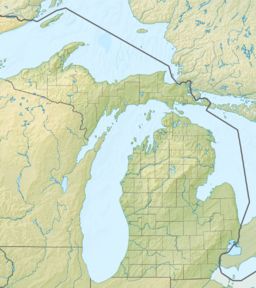| Higgins Lake | |
|---|---|
 Aerial view of the lake's north shore | |
| Location | Roscommon County, Michigan |
| Coordinates | 44°28′56″N 84°42′31″W / 44.48230°N 84.70871°W |
| Type | Glacial Lake |
| Primary inflows | Springs, precipitation, streams, Big Creek |
| Primary outflows | Cut River to Marl Lake |
| Catchment area | 19,000 acres (7,700 ha) |
| Basin countries | United States |
| Max. length | 7 mi (11 km) |
| Max. width | 4 mi (6.4 km) |
| Surface area | 9,600 acres (3,900 ha) |
| Average depth | 44 ft (13 m) |
| Max. depth | 135 ft (41 m) |
| Water volume | almost 20×109 cu ft (0.57 km3) |
| Residence time | 12.5 years |
| Shore length1 | 21 mi (34 km) |
| Surface elevation | 1,155 feet (352 m)[1] |
| Islands | 1 |
| 1 Shore length is not a well-defined measure. | |
Higgins Lake is a large recreational and fishing lake in Roscommon County, in the U.S. state of Michigan. The 9,900 acres (4,000 ha) lake is known for its deep, clear waters and is the 10th largest in Michigan with a shoreline of 21 miles (34 km). It is named after Sylvester Higgins, the first chief of the topographical department of the Michigan Geological Survey. It has a maximum width of 4 miles (6.4 km) and a length of 7 miles (11 km) with a maximum depth of 135 feet (41 m). The mean depth is 44 feet (13 m) and the lake contains almost 20 billion cubic feet (570×106 m3) of water. Its retention time is about 12.5 years. The lake's watershed covers 19,000 acres (7,700 ha). The twin-lobed lake receives half of its water from submerged springs, six percent from incoming streams, and the remainder from direct rainfall and runoff. It drains into Marl Lake by the Cut River which runs into Houghton Lake and eventually to Lake Michigan via the Muskegon River. A mile north of the lake, water flows into the Lake Huron watershed.
Sportfish in the lake include yellow perch, trout, smelt and pike. Fish are taken both in open water and by ice fishing. Higgins Lake is considered a morphometrically oligotrophic lake, meaning that its large size causes it to appear and function as a nutrient-poor lake although it receives a fair amount of nutrients.
The unincorporated community of Higgins Lake is located along the western shores of the lake, and the lake is situated on the boundary between Lyon Township on the west and Gerrish Township on the east.
There are two state parks, located on opposite ends of the lake: South Higgins Lake State Park, which has a mile of shoreline, and North Higgins Lake State Park. Both provide public boat launches and camping, and are very popular in the summer months. The south park is older, larger, and more developed. The north park is located on what was once the world's largest seedling nursery, a part of the Civilian Conservation Corps of the 1930s and early 1940s.
Centuries before European settlers came to North America, the Chippewa people called the lake Majinabeesh, which means 'sparkling water'.

